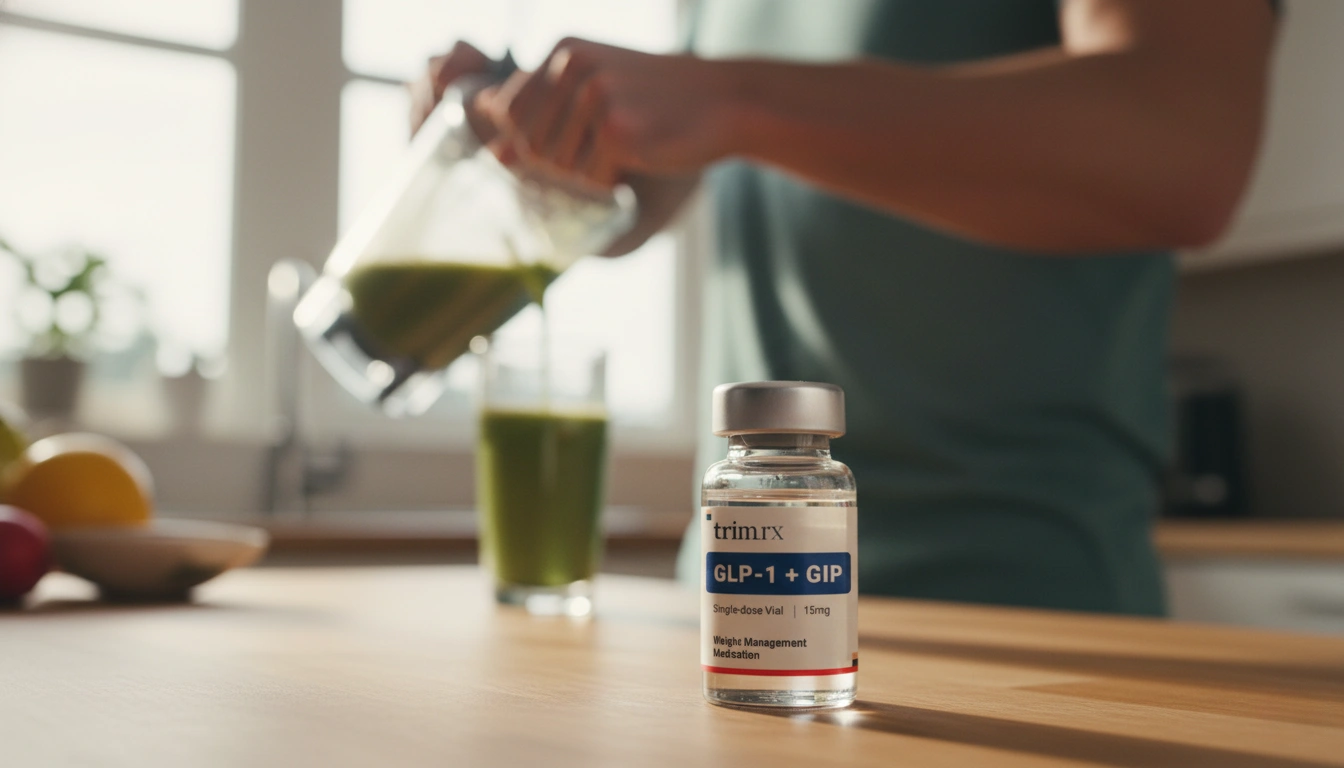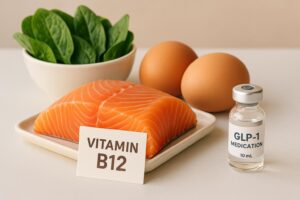What Foods Increase GLP-1 Levels for Better Health and Weight Management?

Glucagon-like peptide-1 (GLP-1) is a hormone that has recently gained attention for its crucial role in appetite regulation and blood sugar control. Did you know that certain foods can significantly boost your body’s production of this beneficial hormone? As people become more health-conscious and aware of the impact of diet on overall well-being, understanding how to naturally increase GLP-1 levels through food is essential.
In this blog post, we will explore the connection between GLP-1 and diet, the specific foods that can enhance GLP-1 secretion, and how these dietary changes can support your weight loss journey and overall health. By the end of this article, you’ll have a comprehensive understanding of what foods to incorporate into your meals to promote GLP-1 production and why it’s beneficial for your health.
Introduction
The buzz surrounding GLP-1 has grown in recent years, especially with the rise of medications that mimic its effects, such as semaglutide and tirzepatide. These medications have revolutionized weight loss and diabetes management, but the good news is that we can also stimulate GLP-1 production naturally through our diet.
Research shows that GLP-1 plays a vital role in regulating blood sugar levels, stimulating insulin release, slowing digestion, and promoting feelings of fullness. Therefore, understanding which foods can naturally increase GLP-1 can empower us to make informed dietary choices that support our health and weight management goals.
In this blog post, we will cover:
- What GLP-1 is and its role in the body
- The relationship between food and GLP-1 secretion
- Specific foods that increase GLP-1 levels
- Practical tips for incorporating these foods into your diet
- The importance of a holistic approach that includes diet, exercise, and mindful eating
Together, we will explore how making conscious food choices can enhance GLP-1 levels, leading to improved appetite control and metabolic health.
Understanding GLP-1
GLP-1 is a hormone produced in the gut that plays multiple roles in metabolism and appetite regulation. It is secreted in response to food intake and contributes to the following processes:
- Stimulating Insulin Release: GLP-1 helps the pancreas release insulin, which lowers blood sugar levels after meals.
- Slowing Gastric Emptying: By slowing the rate at which food leaves the stomach, GLP-1 helps prevent rapid spikes in blood sugar.
- Reducing Hunger: GLP-1 signals the brain to reduce appetite, helping to control food intake and promote a feeling of fullness.
- Inhibiting Glucagon Release: Glucagon is a hormone that raises blood sugar levels. GLP-1 helps to suppress its release, further aiding in blood sugar management.
Given these critical functions, a diet that promotes the natural release of GLP-1 can be an effective strategy for managing weight and improving metabolic health.
How Food Affects GLP-1 Secretion
The foods we eat can influence GLP-1 production through the nutrients they provide. Certain types of nutrients—particularly fiber, protein, and healthy fats—are known to stimulate GLP-1 secretion.
The Role of Fiber
Fiber is a key player in promoting GLP-1 release. When we consume fiber-rich foods, they undergo fermentation in the gut, producing short-chain fatty acids (SCFAs) that stimulate GLP-1 secretion. Soluble fibers, such as those found in fruits, vegetables, legumes, and whole grains, are particularly effective.
The Impact of Protein
Protein-rich foods also play a significant role in GLP-1 secretion. Amino acids derived from protein can stimulate GLP-1 release, making protein an essential component of a GLP-1-boosting diet. High-protein meals can also enhance satiety, reducing the likelihood of overeating.
The Importance of Healthy Fats
Healthy fats, especially unsaturated fats, have been shown to increase GLP-1 levels. Foods like avocados, olive oil, and fatty fish are excellent sources of these beneficial fats that can help promote GLP-1 secretion.
Foods That Increase GLP-1 Levels
Now that we understand the role of different nutrients in GLP-1 secretion, let’s explore specific foods that can enhance GLP-1 production.
1. Eggs
Eggs are a nutritious source of protein and healthy fats. Research suggests that consuming eggs can significantly increase GLP-1 levels. A study found that a breakfast consisting of eggs resulted in lower post-meal blood glucose levels and reduced feelings of hunger compared to a carbohydrate-rich breakfast.
2. Nuts
Nuts, such as almonds, walnuts, and pistachios, are rich in healthy fats, protein, and fiber, making them excellent for boosting GLP-1. The fiber in nuts slows digestion, leading to a gradual release of glucose into the bloodstream and a corresponding increase in GLP-1 secretion.
3. High-Fiber Grains
Whole grains like oats, barley, and quinoa are packed with soluble fiber that promotes GLP-1 production. These grains not only provide essential nutrients but also contribute to improved satiety and weight management.
4. Avocados
Avocados are not only delicious but also high in fiber and monounsaturated fats. Studies have shown that consuming avocados can enhance GLP-1 levels, making them a great addition to a balanced diet. Including avocado in your meals can help you feel fuller for longer, aiding in weight control.
5. Olive Oil
Olive oil, particularly extra virgin olive oil, is rich in healthy fats and has been linked to increased GLP-1 secretion. Incorporating olive oil into your diet can not only enhance flavor but also support your body’s production of this important hormone.
6. Vegetables
Non-starchy vegetables, such as Brussels sprouts, broccoli, and carrots, are high in fiber and vitamins that can positively influence GLP-1 levels. Including a variety of colorful vegetables in your meals can support overall health and enhance satiety.
7. Fruits
Certain fruits, particularly those high in fiber like apples, pears, and citrus fruits, can stimulate GLP-1 secretion. The fiber content in these fruits helps regulate blood sugar levels and promotes feelings of fullness.
8. Beans and Legumes
Beans, lentils, and chickpeas are excellent sources of both protein and fiber. They can help increase GLP-1 levels while providing essential nutrients that support overall health and weight management.
9. Fish
Fatty fish, such as salmon and mackerel, are rich in omega-3 fatty acids, which have been shown to improve insulin sensitivity and enhance GLP-1 secretion. Including fish in your diet can provide numerous health benefits.
10. Fermented Foods
Fermented foods like yogurt, kefir, and sauerkraut contain beneficial probiotics that can support gut health. A healthy gut microbiome is crucial for the production of SCFAs, which in turn stimulate GLP-1 secretion.
Practical Tips for Incorporating GLP-1-Boosting Foods
Now that we’ve identified the foods that can help increase GLP-1 levels, let’s discuss practical ways to incorporate them into your daily meals.
-
Start Your Day with Protein: Begin your day with a protein-rich breakfast containing eggs or Greek yogurt topped with fruits and nuts. This can help kickstart GLP-1 production and keep you feeling full longer.
-
Snack Smart: Choose nuts or a piece of fruit as a healthy snack. This will not only provide essential nutrients but also support GLP-1 secretion.
-
Add Whole Grains: Swap out refined grains for whole grains like quinoa, brown rice, or oats in your meals. These grains are higher in fiber and can enhance GLP-1 levels.
-
Include Healthy Fats: Drizzle olive oil on salads or vegetables and include avocados in your meals. These healthy fats can support GLP-1 production and improve overall satiety.
-
Fill Your Plate with Vegetables: Aim to fill half your plate with non-starchy vegetables at every meal. This will not only boost fiber intake but also provide essential vitamins and minerals.
-
Experiment with Legumes: Incorporate beans and lentils into soups, stews, or salads for added protein and fiber. They are versatile and can be easily included in various dishes.
-
Choose Fatty Fish: Aim to include fatty fish at least twice a week. This can provide omega-3 fatty acids that support GLP-1 production and overall health.
The Importance of a Holistic Approach
While dietary choices play a significant role in boosting GLP-1 levels, it’s essential to adopt a holistic approach that includes regular physical activity and mindful eating practices.
Exercise and GLP-1
Regular physical activity has been shown to enhance GLP-1 levels. Engaging in aerobic and resistance training can improve insulin sensitivity and promote overall metabolic health. Aim for at least 150 minutes of moderate-intensity exercise each week, along with two days of strength training.
Mindful Eating
Practicing mindful eating can further support GLP-1 production by encouraging slower eating and greater awareness of hunger cues. Take the time to savor your meals, chew slowly, and listen to your body’s signals of fullness. This practice can help regulate appetite and improve overall eating habits.
Conclusion
Increasing GLP-1 levels through dietary choices can be a powerful strategy for managing appetite, regulating blood sugar, and supporting weight loss. By incorporating foods rich in fiber, protein, and healthy fats into our diets, we can empower ourselves to make healthier choices and enhance our overall well-being.
At TrimRx, we believe in the importance of personalized, medically supervised weight loss solutions that combine advanced medical science with modern technology. We encourage you to take our free assessment quiz to discover if you qualify for our prescription weight loss medications, which can support your efforts in achieving sustainable weight loss.
Additionally, consider trying our quick-access supplements, such as GLP-1 Daily Support and Weight Loss Boost, to enhance your journey toward better health.
Together, let’s embrace healthier lifestyles and discover the benefits of food choices that promote GLP-1 production.
FAQ
What is GLP-1, and why is it important?
GLP-1 is a hormone produced in the gut that plays a crucial role in regulating blood sugar levels, stimulating insulin release, slowing digestion, and reducing appetite. It is vital for managing weight and metabolic health.
What foods can help increase GLP-1 levels?
Foods that can boost GLP-1 production include eggs, nuts, high-fiber grains, avocados, olive oil, non-starchy vegetables, fruits, beans, fatty fish, and fermented foods.
Can exercise increase GLP-1 levels?
Yes, regular physical activity can enhance GLP-1 levels and improve insulin sensitivity, contributing to better metabolic health.
How can I incorporate GLP-1-boosting foods into my diet?
Start with protein-rich breakfasts, choose healthy snacks like nuts or fruit, swap refined grains for whole grains, include healthy fats, fill your plate with vegetables, and experiment with legumes.
Is it possible to get the same effects from supplements?
While supplements may support weight management, they cannot replicate the full effects of a healthy diet. Prioritizing whole foods is essential for long-term health benefits.
By making informed dietary choices and adopting a holistic approach, we can all work towards better health and well-being.

Transforming Lives, One Step at a Time
Keep reading
Vitamin B12 and GLP-1 Medications: What to Know
GLP-1 medications can lower B12 absorption and intake; learn symptoms, food sources, supplement options, and how to monitor levels.
Semaglutide Injection Site Reactions: What To Know
Learn why semaglutide injections can cause redness, swelling or nodules, how to prevent and treat them, and when to seek medical care.
TrimRx vs Friday’s
Compare TrimRx and Friday’s telehealth GLP-1 weight-loss programs: pricing, medical support, coaching, delivery, and which fits your needs.



